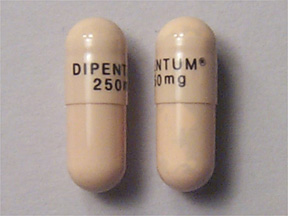Olsalazine (Monograph)
Brand name: Dipentum
Drug class: Anti-inflammatory Agents
VA class: GA900
Chemical name: 3,3′-azobis[6-hydroxybenzoic acid disodium salt
Molecular formula: C14H8N2Na2O6
CAS number: 6054-98-4
Introduction
Anti-inflammatory agent with GI tract activity; a 5-aminosalicylic acid derivative and a prodrug of mesalamine.
Uses for Olsalazine
Ulcerative Colitis
Used to maintain clinical remission in patients who are intolerant of sulfasalazine.
Crohn’s Disease
May be beneficial in the management of Crohn’s disease† [off-label] involving the colon.
Olsalazine Dosage and Administration
Administration
Oral Administration
Administer orally twice daily with food.
Dosage
Dosage of olsalazine sodium, which is commercially available as the disodium salt, is expressed in terms of olsalazine sodium.
Daily dosage of 1g usually provides >0.9 g of mesalamine in the colon.
Adults
Ulcerative Colitis
Oral
500 mg twice daily.
Cautions for Olsalazine
Contraindications
-
Known hypersensitivity to salicylates, olsalazine or its metabolites, or any ingredient in the formulation.
Warnings/Precautions
Major Toxicities
Diarrhea
Diarrhea (reported in about 17% of patients) has required discontinuance in about 6% of patients.
Diarrhea/loose stools, possibly dose-related, tend to occur within 1 week of initiating the drug or a dosage increase.
Occasionally bloody and difficult to distinguish from underlying disease symptoms or may be distinguishable by its high water content and absence of blood. Possibly more severe and frequent in patients with extensive ulcerative colitis.
Usually transient and dosage reduction or increased frequency of dosing of the drug and concomitant administration of food or an antidiarrhea agent (e.g., loperamide) may reduce severity.
May resolve without dosage reduction and once it has resolved, may not recur.
General Precautions
GI effects
Exacerbation of preexisting symptoms of ulcerative colitis has been reported with other 5-aminosalicylic acid derivatives (e.g., mesalamine, sulfasalazine).
Sodium Content
Each g of olsalazine sodium, which contains the disodium salt, provides approximately 5.78 mEq (133 mg) of sodium.
Specific Populations
Pregnancy
Category C.
Lactation
Distributed into milk in rats; not known whether distributed into human milk. Use caution.
Pediatric Use
Safety and efficacy not established.
Geriatric Use
Insufficient experience in patients ≥65 years of age to determine whether geriatric patients respond differently than younger adults.
Renal Impairment
Use with caution in patients with renal impairment, since renal tubular damage has been reported in animals and rarely in postmarketing surveillance; perform urinalysis, monitor serum creatinine and BUN concentrations in such patients.
Common Adverse Effects
Diarrhea/loose stools, abdominal pain or cramps, nausea, dyspepsia, heartburn, bloating, anorexia, vomiting, stomatitis, rectal bleeding, headache, fatigue, drowsiness, lethargy, depression, insomnia, vertigo, dizziness or lightheadedness, rash, pruritus, arthralgia or joint pain, upper respiratory infection.
Drug Interactions
Specific Drugs
|
Drug |
Interaction |
|---|---|
|
Warfarin |
Potential interaction (increased prothrombin time). |
Olsalazine Pharmacokinetics
Absorption
Bioavailability
Olsalazine (prodrug) has limited systemic bioavailability; about 2.4% of an oral dose may be absorbed.
Most (98–99%) of an oral dose reaches the colon intact resulting in very high local concentrations of the active metabolite mesalamine.
Distribution
Plasma Protein Binding
Olsalazine: >99%; Mesalamine: 74%; N-acetyl-5-acetylsalicylic acid (a metabolite): 81%.
Crosses placenta in animals.
Distributed into milk in rats; not known whether distributed into human milk.
Elimination
Metabolism
Azo-linkage is cleaved in the colon by intestinal flora to form 2 molecules of mesalamine.
Mesalamine is rapidly acetylated in colonic epithelium and liver to N-acetyl-5-acetylsalicylic acid.
0.1% of olsalazine is metabolized in the liver to olsalazine-O-sulfate.
Elimination Route
Mesalamine is excreted principally in feces as N-acetyl-5-acetylsalicylic acid, and to a lesser extent in urine (about 20%) mostly as N-acetyl-5-acetylsalicylic acid; <1% of olsalazine excreted in urine unchanged.
Half-life
Olsalazine: approximately 0.9 hours. Olsalazine-O-sulfate: 7 days.
Stability
Storage
Oral
Capsules
25°C (may be exposed to 15–30°C).
Actions
-
Prodrug with little or no anti-inflammatory activity until cleaved to form mesalamine (active moiety).
-
Exerts local (not systemic) anti-inflammatory effects in the GI tract.
-
May reduce inflammation in the colon by inhibiting cyclooxygenase and lipoxygenase, which catalyze the formation of prostaglandin precursors (endoperoxides) and of leukotrienes and hydroxyeicosatetraenoic acids, respectively, from arachidonic acid and/or its metabolites.
-
Importance of taking with food.
-
Importance of taking in equally divided doses.
-
Importance of informing clinicians if diarrhea occurs.
-
Importance of informing clinicians of existing or contemplated concomitant therapy, including prescription and OTC drugs.
-
Importance of women informing clinicians if they are or plan to become pregnant or plan to breast-feed.
-
Importance of advising patients of other important precautionary information. (See Cautions.)
Preparations
Excipients in commercially available drug preparations may have clinically important effects in some individuals; consult specific product labeling for details.
Please refer to the ASHP Drug Shortages Resource Center for information on shortages of one or more of these preparations.
|
Routes |
Dosage Forms |
Strengths |
Brand Names |
Manufacturer |
|---|---|---|---|---|
|
Oral |
Capsules |
250 mg |
Dipentum |
Celltech |
AHFS DI Essentials™. © Copyright 2024, Selected Revisions September 1, 2005. American Society of Health-System Pharmacists, Inc., 4500 East-West Highway, Suite 900, Bethesda, Maryland 20814.
† Off-label: Use is not currently included in the labeling approved by the US Food and Drug Administration.
Reload page with references included
More about olsalazine
- Check interactions
- Compare alternatives
- Reviews (4)
- Side effects
- Dosage information
- During pregnancy
- Drug class: 5-aminosalicylates
- Breastfeeding
- En español

